Experimental Study on the Stability and Wave Force of a Breakwater Transition under Multiangle Oblique Waves
Abstract
1. Introduction
2. Model Test Design
2.1. Project Background
2.2. Model Design
2.3. Test Condition Design and Environmental Simulation
- Water level conditions: In order to reflect the influence of overtopping on stability and wave force, two water levels of +5.90 m and +0.57 m were selected for the test.
- Wave conditions: According to the distribution of wave frequency in the open sea and the consideration of the most unfavorable waves, four angles, = 5°, 15°, 35°, and 75°, were selected between the wave incidence direction and the axis of the breakwater. See Table 1 for wave elements. (Note: the definition method of is the same as above. See Figure 2 for details). See Table 1 for the test conditions.
2.4. Layout of Measuring Points
3. Results
3.1. Analysis of the Wave Characteristics Change Law
3.2. Analysis of the Force Variation Law of the Vertical Caisson
3.2.1. Variation Law of the Wave Force
3.2.2. Variation Law of the Maximum Wave Pressure
- Pressure distribution at the moment of the maximum wave force
- 2.
- Distribution law of the maximum pressure at each measuring point
3.3. Analysis of the Stability Variation Law of the Armor Block
4. Discussion
5. Conclusions
- (1)
- For the unfavorable hydrodynamic environment characteristics of the breakwater transition, the maximum overtopping volume was 0.345 m3 (m·s)−1, the maximum specific wave height was 2.05, and other key parameters were obtained. Compared with the calculation results of the Chinese standard formula and the Van der Meer empirical formula, the maximum overtopping volume and the wave crest height are 1.95 and 1.39 times the calculation of the latter, respectively.
- (2)
- The wave force on the caisson was directly proportional to the incident wave direction angle and inversely proportional to the water level; that is, the wave action at the low water level β = 75° was the largest, and the horizontal force and the buoyancy force were = 935.6 kN and = 419.1 kN, respectively. Compared with the calculation results of the Chinese code formula and the Goda empirical formula, the maximum wave force was 1.60 times the calculation of the latter.
- (3)
- For the instability mechanism of the Accropode at the transition of the breakwater, it was mainly caused by the poor connection between the armor block and the caisson, as well as by the wave energy concentration and other adverse factors.
- (4)
- For the weight of the Accropode, the designs weighing 2T and 8T were unstable, and were only stable after optimization tests for 8T and 12T. Compared with the calculation results of the Chinese code formula, the maximum test result is 2.50 times the calculation. Therefore, for special areas, the stable weight of the armor block under oblique wave action is not reduced, but is instead multiplied by an amplification factor of 1.47–2.50, according to this test.
Author Contributions
Funding
Institutional Review Board Statement
Informed Consent Statement
Data Availability Statement
Acknowledgments
Conflicts of Interest
References
- Wang, M.R. Inquiry on the design method for deep-water breakwater. Port Eng. Technol. 2010, 47, 1–7+41. [Google Scholar] [CrossRef]
- Xu, P.L. Discussion on stone dumping and filling construction and quality control of deep-water breakwater. Build. Eng. Technol. Des. 2020, 17, 2392. [Google Scholar] [CrossRef]
- Zhuo, M.C. Research on construction technology of stone dumping and filling of deep-water breakwater. Real Estate Guide 2014, 14, 400. [Google Scholar] [CrossRef]
- Qiu, X.B.; Qin, J.; Chen, L.Z. Brief analysis on repair design of typhoon damaged breakwater. Port Eng. Technol. 2021, 58, 15–17. [Google Scholar] [CrossRef]
- Ju, J. Damage and cause analysis of port breakwater. Urban Archit. 2014, 35, 307. [Google Scholar] [CrossRef]
- Ge, L.Z. Research Report on Local Wave Physical Model Test of Breakwater Restoration Project after Typhoon "Shanzhu" in 2018; Tianjin Research Institute for Water Transport Engineering: Tianjin, China, 2019. [Google Scholar]
- Zhang, H.C.; Dong, S.; Liu, Y.L.; Li, Y.L. Experimental study on the action of oblique irregular waves on the head of sloping breakwater. Water Transp. Eng. 2013, 4, 20–24. [Google Scholar] [CrossRef]
- Chang, M.; Xia, Y.Q.; Zhang, H.C.; Liu, Y.L. Discussion on the stable weight of armor block under the action of oblique waves. Port Eng. Technol. 2017, 54, 40–42+47. [Google Scholar] [CrossRef]
- Jiang, Y.P.; Liu, C.X.; Peng, C. Impact of steep slope and gentle slope topography on revetment works under wave action. Water Transp. Eng. 2015, 4, 61–65. [Google Scholar] [CrossRef]
- Wu, S.S.; Zhang, W.; Yuan, H.P. Study on stability characteristics of concrete interlocking row at different parts of bottom protection. Water Transp. Eng. 2008, 11, 53–57. [Google Scholar] [CrossRef]
- Clemente, D.; Calheiros-Cabral, T.; Rosa-Santos, P.; Taveira-Pinto, F. Hydraulic and Structural Assessment of a Rubble-Mound Breakwater with a Hybrid Wave Energy Converter. J. Mar. Sci. Eng. 2021, 9, 922. [Google Scholar] [CrossRef]
- Vicinanza, D.; Contestabile, P.; Quvang Harck Nørgaard, J.Q.H.; Lykke Andersen, T. Innovative rubble mound breakwaters for overtopping wave energy conversion. Coast. Eng. 2014, 88, 154–170. [Google Scholar] [CrossRef]
- Kralli, V.-E.; Theodossiou, N.; Karambas, T. Optimal Design of Overtopping Breakwater for Energy Conversion (OBREC) Systems Using the Harmony Search Algorithm. Front. Energy Res. 2019, 7, 11. [Google Scholar] [CrossRef]
- Tsang, S.Y.; Liaw, S.R. A design short-crested wave force model for vertical deep-water breakwaters. In Proceedings of the Coastal Engineering ASCE, Tokyo, Japan, 3–6 March 2012; pp. 563–735. [Google Scholar]
- Allsop, N.W.H.; Calabrese, M. Impact loadings on vertical walls in directional seas. In Proceedings of the 26th International Conference on Coastal Engineering, Copenhagen, Denmark, 22–26 June 1998; pp. 2056–2068. [Google Scholar]
- Battjies, J.A. Effects of short-crestedness on wave loads on long structures. Appl. Ocean. Res. 1982, 4, 165–172. [Google Scholar] [CrossRef]
- Goda, Y. Random Seas and Design Marine Structures; University of Tokyo Press: Tokyo, Japan, 1985; pp. 116–119. [Google Scholar]
- Goda, Y.; Tabata, T.; Yamamoto, S. Technical Standards and Commentaries for Port and Harbour Facilities in Japan; The Overseas Coastal Area Development Institute of Japan: Tokyo, Japan, 2002. [Google Scholar]
- Chen, J.; Duan, Z.H.; Cui, Y.Q.; Guan, J.; Gao, Q.Y.; Cao, C. Experimental Study on Tsunami Local Scour Law in the Entrance Area of Vertical Breakwater. Ocean Bull. 2017, 36, 475–480. [Google Scholar] [CrossRef]
- Franco, C.; Van Der Meer, J.W.; Franco, L. Multidirectional wave loads on vertical breakwaters. In Proceedings of the 25th International Conference on Coastal Engineering, Orlando, FL, USA, 2–6 September 1996; pp. 2008–2021. [Google Scholar]
- Hong, G.G.; Wen, F.; Wei, B. Theoretical Model and Random Simulation for Nonlinear Interaction of Irregular Waves with Vertical Wall. China Ocean Eng. 1993, 7, 263–288. [Google Scholar]
- Madrigal, B.G. Loads on caisson breakwaters in multidirectional random non-breaking seas. In Proceedings of the 5th International Conference on Coastal and Port Engineering in Developing Countries, Cape Town, South Africa, 29 September–2 October 2019; pp. 1314–1326. [Google Scholar]
- Li, B.X.; Yu, Y.X.; Zhang, N.C. Wave force of multi-directional random wave acting on vertical breakwater. J. Dalian Univ. Technol. 2004, 44, 575–581. [Google Scholar] [CrossRef]
- Yu, Y.X.; Li, B.X.; Zhang, N.C.; Hu, J.P. Wave load of oblique and multi-directional irregular waves acting on straight wall embankment. Water Transp. Eng. 2011, 1, 24–28. [Google Scholar] [CrossRef]
- Hsu, J.C. Short Peak Wave. Coastal and Marine Engineering Manual; Dalian University of Technology Press: Dalian, China, 1922; pp. 69–129. [Google Scholar]
- Fenton, J.D. Wave forces on vertical walls. J. Waterw. Port Coast. Ocean Eng. 1985, 111, 693–718. [Google Scholar] [CrossRef]
- Wang, H.L.; Zhang, Y.; Zhao, J. Wave force analysis on small angle change of wave face of vertical breakwater. Water Transp. Eng. 2022, 29–38, 44. [Google Scholar] [CrossRef]
- Hsu, H.C.; Chen, Y.Y.; Chen, Y.R.; Li, M.S. Experimental Study of Forces Influencing Vertical Breakwater under Extreme Waves. Water 2022, 14, 657. [Google Scholar] [CrossRef]
- Cuomo, G.; Allsop, W.; Bruce, T.; Pearson, J. Breaking wave loads at vertical seawalls and breakwaters. Coast. Eng. 2010, 57, 424–439. [Google Scholar] [CrossRef]
- Alam, M.S.; Winter, A.O.; Galant, G.; Shekhar, K.; Barbosa, A.R.; Motley, M.R.; Eberhard, M.O.; Cox, D.T.; Arduino, P.; Lomonaco, P. Tsunami-Like Wave-Induced Lateral and Uplift Pressures and Forces on an Elevated Coastal Structure. J. Water. Port Coast. Ocean Eng. 2020, 146, 04020008. [Google Scholar] [CrossRef]
- Ge, L.; Chen, H.; Chen, S.; Liu, H.Y. Experimental Study on Wave Current Characteristics and Stability of the Junction of Artificial Island and Subsea Tunnel. J. Mar. Sci. Eng. 2022, 10, 1525. [Google Scholar] [CrossRef]
- Zhang, H.C.; Dong, S.; Liu, Y.L.; Wang, H.F. The law of oblique wave propagation along vertical breakwater and its influence on the bank slope breakwater. In Proceedings of the 15th China Ocean (Coastal) Engineering Symposium, Taiyuan China, 3–6 August 2011; pp. 727–731. [Google Scholar]
- Ge, L.Z.; Luan, Y.N.; Chen, H.B.; Liu, H.Y. Experimental study on stability of breakwater junction block under oblique wave action and wave force on caisson structure. Oceanogr. Bull. 2021, 40, 113–120. [Google Scholar] [CrossRef]
- Kuai, Y.R.; Qi, M.L.; Li, J.Z. Wave force analysis of bridge substructure near the coast. J. Zhejiang Univ. Eng. Ed. 2018, 52, 2356–2364. [Google Scholar] [CrossRef]
- Shao, T.Z.; Guo, F.L. Research on the Layout of Artificial Beach Sand Retaining Dike in Rizhao Port Return to Sea Project. Waterw. Port 2020, 41, 157–165. [Google Scholar] [CrossRef]
- Ministry of Transport. Technical Code for Simulation Test of Water Transportation Engineering; People’s Communications Publishing House Co., Ltd.: Beijing, China, 2021. [Google Scholar]
- Ministry of Transport. Code of Hydrology for Harbor and Waterway; People’s Communications Publishing House Co., Ltd.: Beijing, China, 2015. [Google Scholar]
- Bruce, T.; Van der Meer, J.W.; Franco, L.; Pearson, J. A comparison of overtopping performance of different rubble mound breakwater armour. In Proceedings of the 30th International Conference on Coastal Engineering, San Diego, CA,,USA, 3–8 September 2006; pp. 1034–1043. [Google Scholar]
- Ministry of Transport. Code for Design of Breakwater and Revetment; People’s Communications Publishing House Co., Ltd.: Beijing, China, 2018. [Google Scholar]
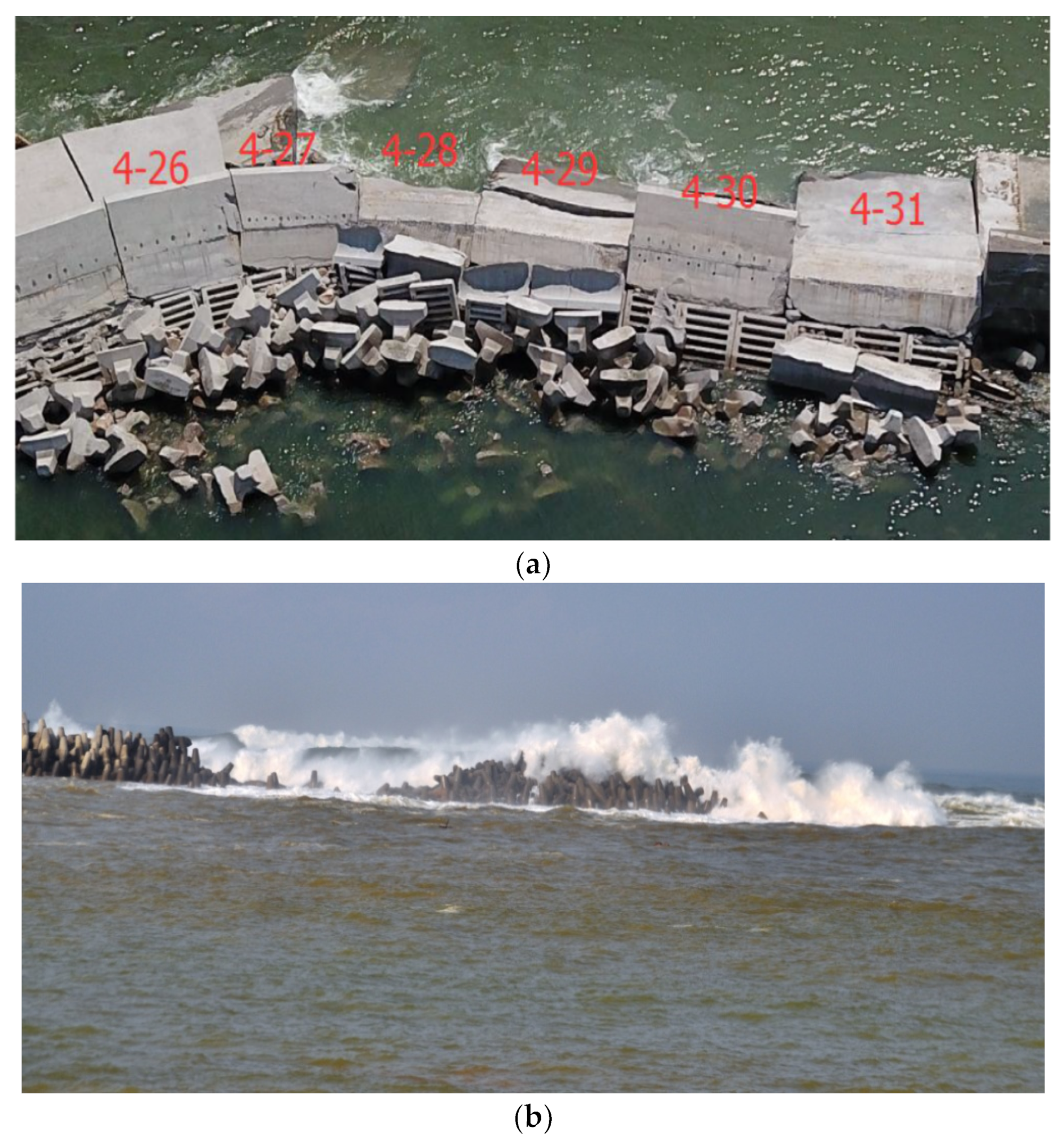
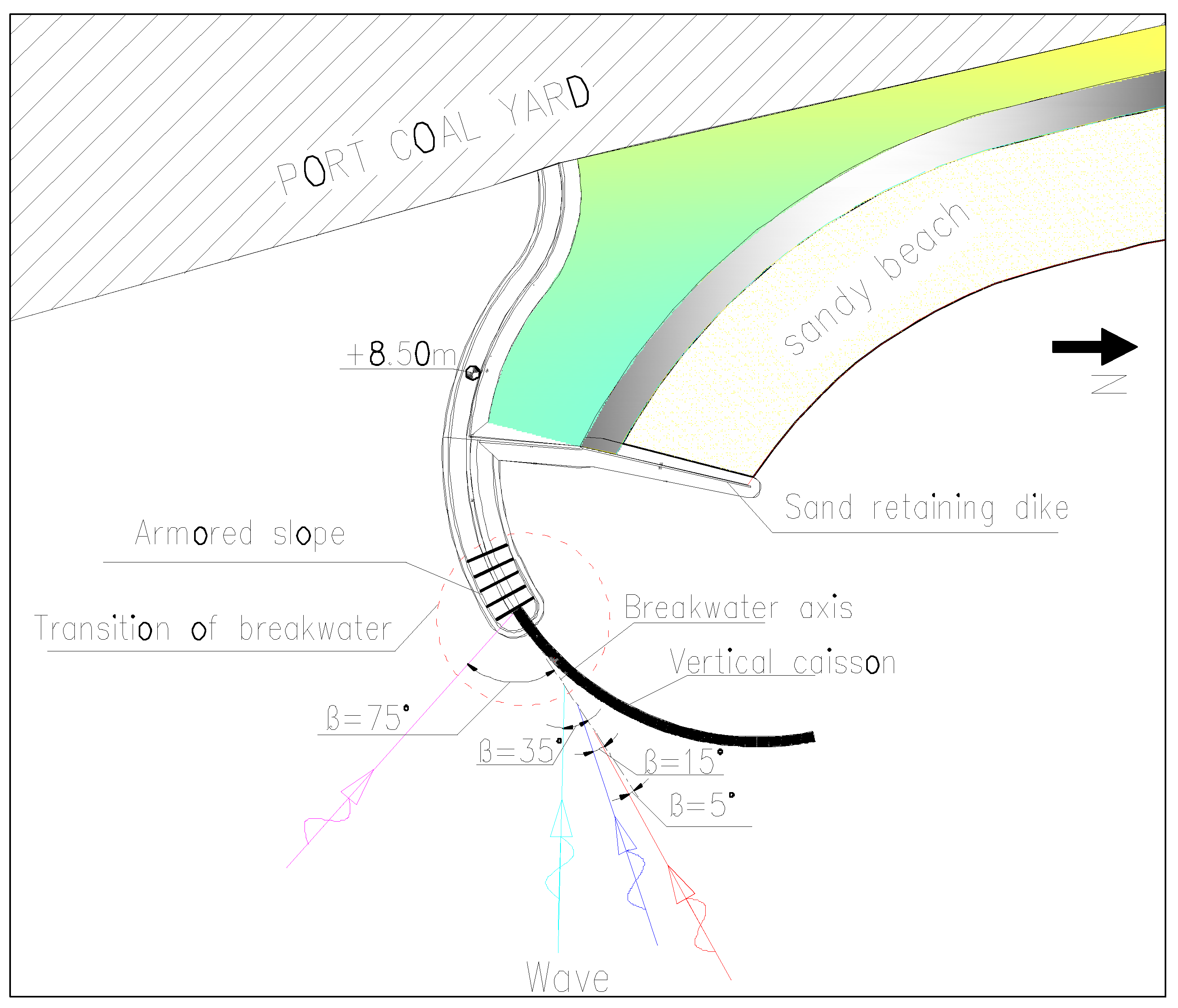


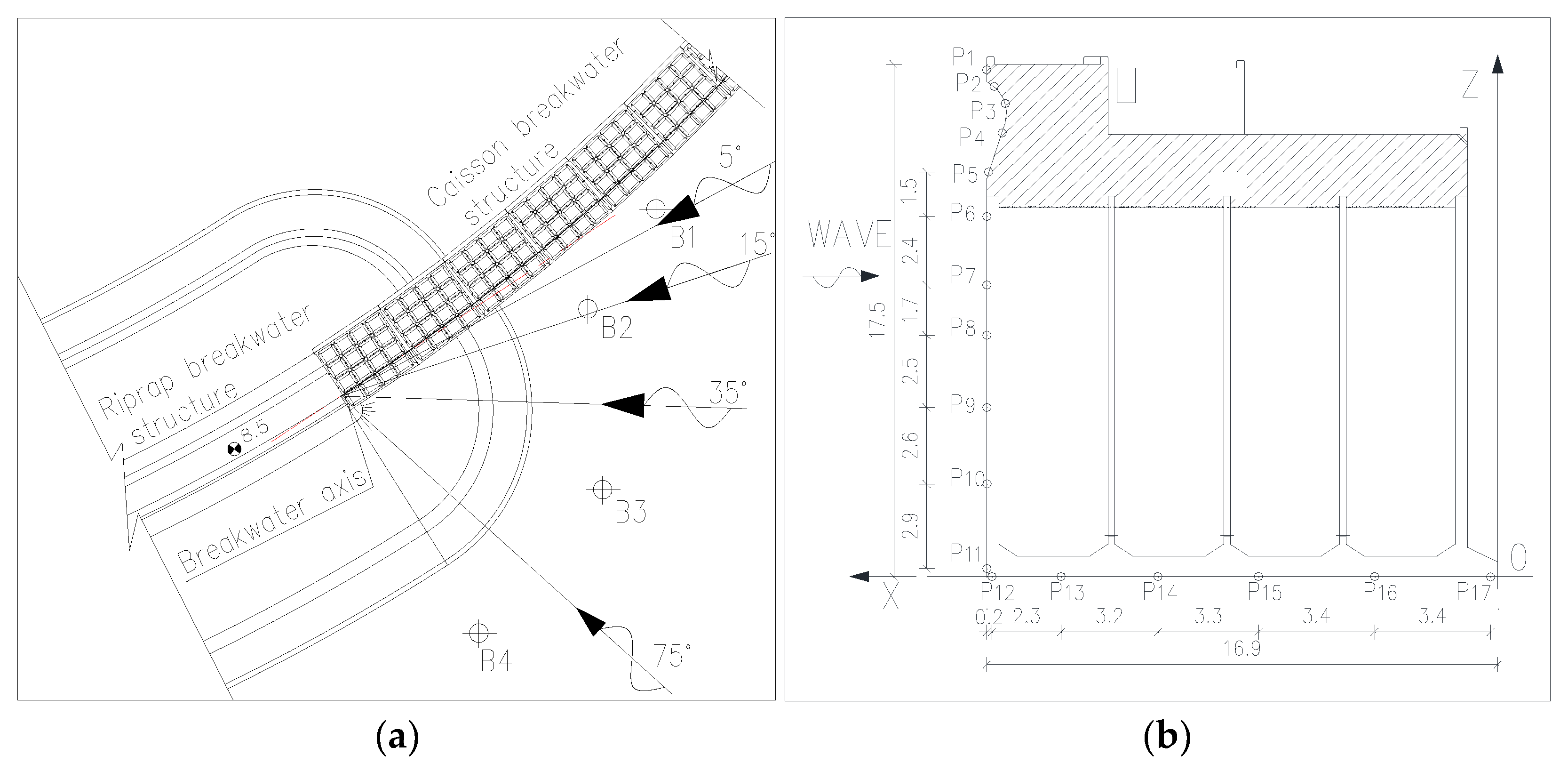

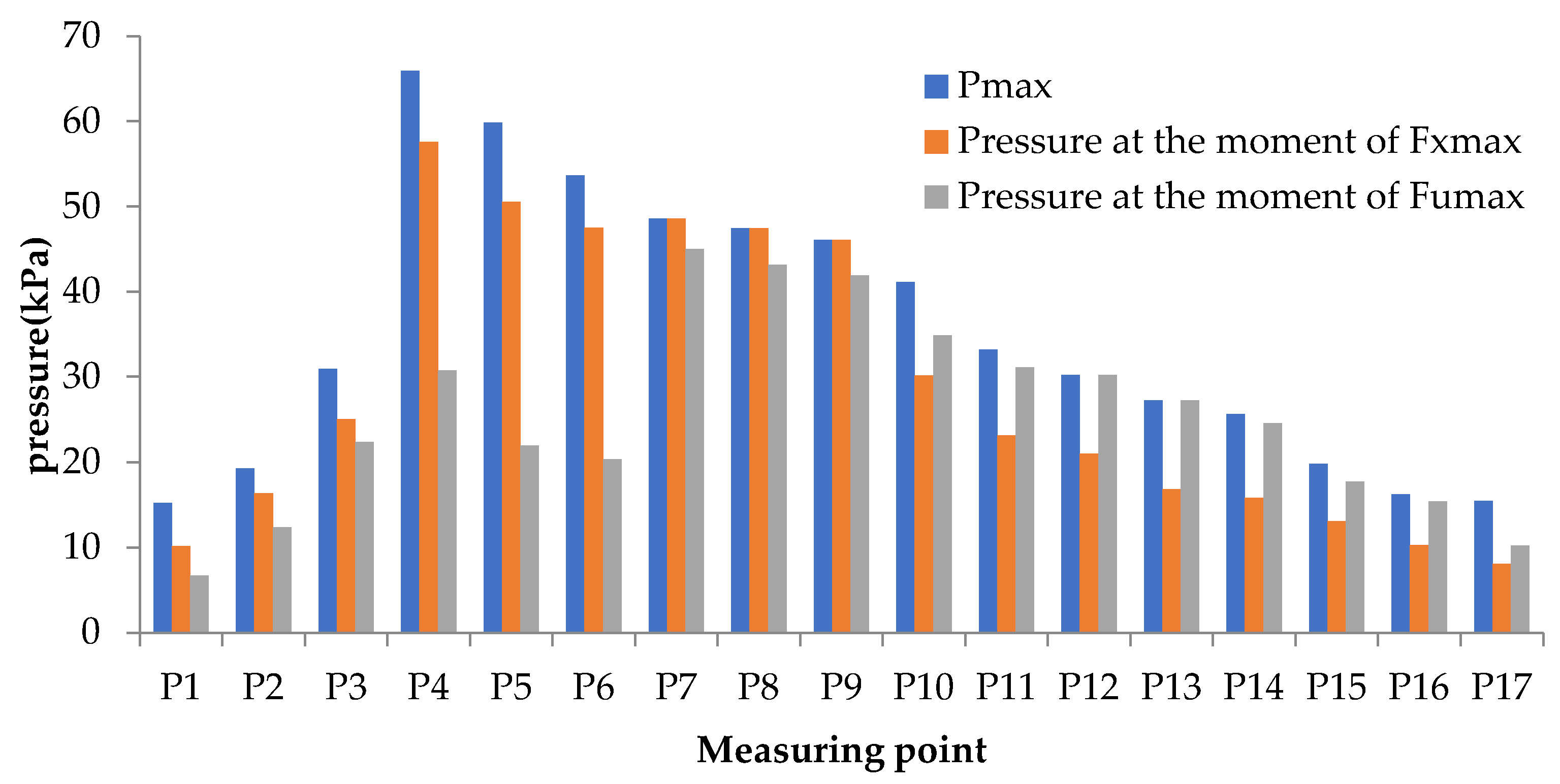
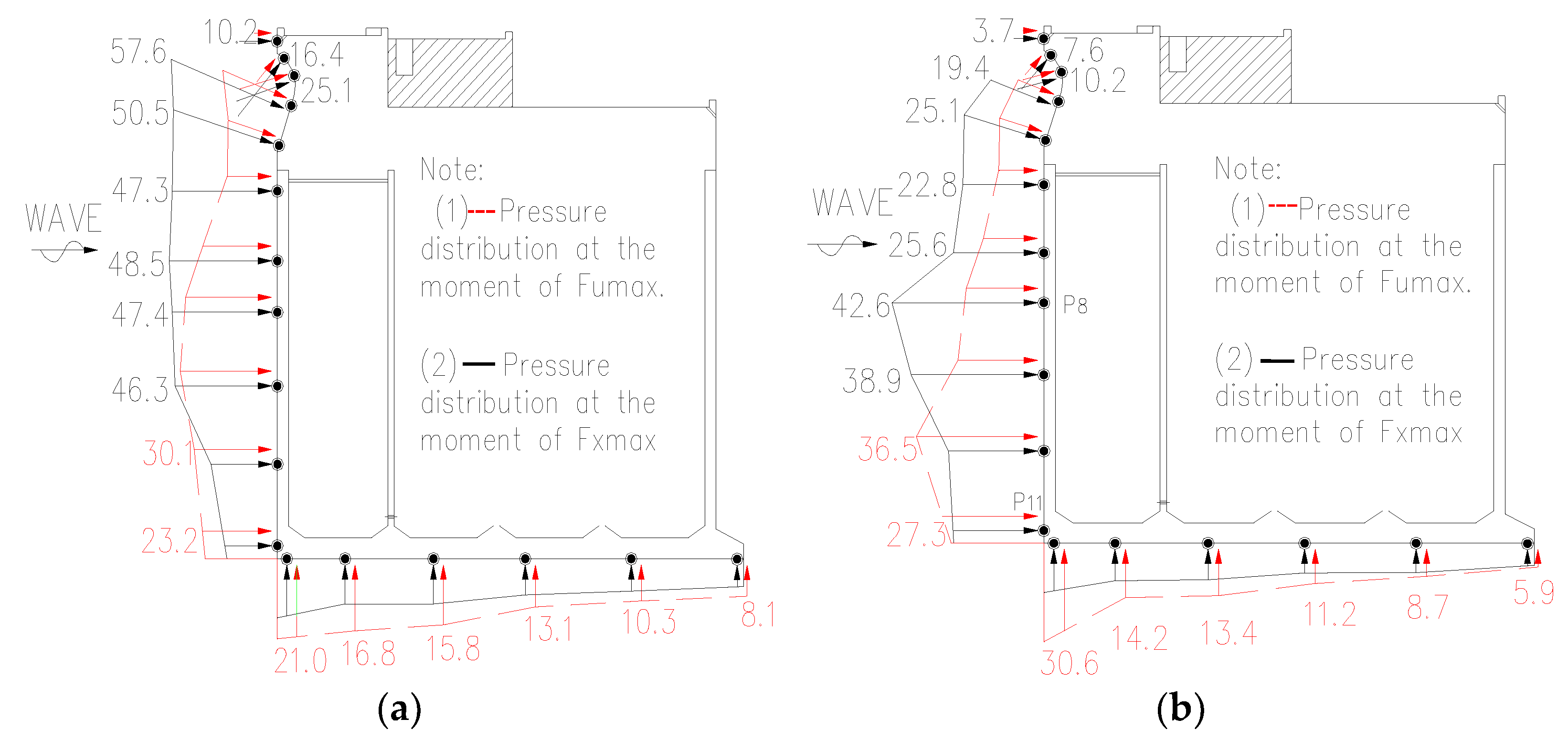


| Type | Wave Direction | W.L (m) | Hs (m) | ||
|---|---|---|---|---|---|
| Prototype value | 5°, 15°, 35°, 75° | +5.90 | 6.77 | 4.88 | 8.9 |
| +0.57 | 5.24 | 3.83 | 8.9 | ||
| Model value | 5°, 15°, 35°, 75° | +0.16 | 0.19 | 0.14 | 1.48 |
| +0.02 | 0.15 | 0.11 | 1.48 |
| Point | Sj(m2) | Point | Sj(m2) |
|---|---|---|---|
| P1 | 29.9 | P10 | 97.2 |
| P2 | 25.2 | P11 | 70.2 |
| P3 | 33.5 | P12 | 51.8 |
| P4 | 41.8 | P13 | 103.0 |
| P5 | 35.3 | P14 | 118.4 |
| P6 | 86.0 | P15 | 126.4 |
| P7 | 79.6 | P16 | 132.1 |
| P8 | 75.2 | P17 | 74.9 |
| P9 | 83.5 | / | / |
| Wave Direction | Q(m3·(m·s)−1) | Correction Factor | |||
|---|---|---|---|---|---|
| Test Value | Calculated Value | ||||
| Chinese Standards | Van der Meer | Chinese Standards | Van der Meer | ||
| 5° | 0.056 | 0.031 | 0.036 | 1.82 | 1.56 |
| 15° | 0.134 | 0.069 | 0.082 | 1.95 | 1.63 |
| 35° | 0.345 | 0.205 | 0.220 | 1.68 | 1.57 |
| 75° | 0.274 | 0.156 | 0.145 | 1.76 | 1.89 |
| Wave | Point | W.L (+0.57 m) | W.L (+5.90 m) | ||||||
|---|---|---|---|---|---|---|---|---|---|
| Specific Wave Height | Maximum Wave Crest Height | Specific Wave Height | Maximum Wave Crest Height | ||||||
| Test value | Calculated Value | Correction Factor | Test Value | Calculated Value | Correction Factor | ||||
| 5° | B1 | 1.38 | 5.01 | 3.74 | 1.34 | 1.25 | 4.79 | 3.66 | 1.31 |
| B2 | 1.58 | 5.60 | 1.50 | 1.39 | 5.80 | 1.58 | |||
| B3 | 1.42 | 5.31 | 1.42 | 1.28 | 5.35 | 1.46 | |||
| B4 | 1.35 | 4.96 | 1.33 | 1.21 | 4.71 | 1.29 | |||
| 15° | B1 | 1.42 | 5.84 | 4.21 | 1.39 | 1.30 | 5.79 | 4.05 | 1.43 |
| B2 | 1.83 | 7.08 | 1.68 | 1.52 | 6.91 | 1.71 | |||
| B3 | 1.70 | 6.15 | 1.46 | 1.39 | 6.04 | 1.49 | |||
| B4 | 1.53 | 5.99 | 1.42 | 1.28 | 5.79 | 1.43 | |||
| 35° | B1 | 1.64 | 7.33 | 4.77 | 1.54 | 1.59 | 7.75 | 4.86 | 1.59 |
| B2 | 2.05 | 8.90 | 1.87 | 1.91 | 9.32 | 1.59 | |||
| B3 | 1.86 | 7.66 | 1.61 | 1.74 | 8.49 | 1.59 | |||
| B4 | 1.65 | 7.12 | 1.49 | 1.53 | 7.63 | 1.59 | |||
| 75° | B1 | 1.68 | 9.70 | 4.93 | 1.97 | 1.61 | 8.74 | 4.73 | 1.85 |
| B2 | 1.87 | 9.17 | 1.86 | 1.56 | 8.43 | 1.78 | |||
| B3 | 1.66 | 8.09 | 1.64 | 1.42 | 7.60 | 1.61 | |||
| B4 | 1.49 | 7.55 | 1.53 | 1.36 | 6.58 | 1.39 | |||
| W.L | Wave Direction | ||||||||||
|---|---|---|---|---|---|---|---|---|---|---|---|
| Test Value | Calculated Value | Correction Factor | Test Value | Calculated Value | Correction Factor | ||||||
| C-S | G-E | C-S | G-E | C-S | G-E | C-S | G-E | ||||
| +5.90 m | 5° | 445.5 | 320.5 | 313.7 | 1.39 | 1.42 | 228.3 | 191.8 | 184.1 | 1.19 | 1.24 |
| 15° | 654.2 | 457.5 | 503.2 | 1.43 | 1.30 | 292.9 | 242.1 | 227.1 | 1.21 | 1.29 | |
| 35° | 718.0 | 448.8 | 531.9 | 1.60 | 1.35 | 278.0 | 210.6 | 237.6 | 1.32 | 1.17 | |
| 75° | 787.1 | 521.3 | 558.2 | 1.51 | 1.41 | 337.8 | 263.9 | 270.2 | 1.28 | 1.25 | |
| +0.57 m | 5° | 489.7 | 371.0 | 333.1 | 1.32 | 1.47 | 289.9 | 256.5 | 239.6 | 1.13 | 1.21 |
| 15° | 644.3 | 477.3 | 473.8 | 1.35 | 1.36 | 349.0 | 277.0 | 283.7 | 1.26 | 1.23 | |
| 35° | 835.5 | 535.6 | 668.4 | 1.56 | 1.25 | 358.5 | 261.7 | 267.5 | 1.37 | 1.34 | |
| 75° | 935.6 | 588.4 | 673.1 | 1.59 | 1.39 | 419.1 | 332.6 | 358.2 | 1.26 | 1.17 | |
| W.L | Point | Pressure (kPa) | Point | Pressure (kPa) | ||||
|---|---|---|---|---|---|---|---|---|
| Test Value | Calculated Value | Correction Factor | Test Value | Calculated Value | Correction Factor | |||
| +5.90 m | P1 | 15.2 | 12.5 | 1.22 | P10 | 41.1 | 37.1 | 1.11 |
| P2 | 19.3 | 16.9 | 1.14 | P11 | 33.2 | 31.0 | 1.07 | |
| P3 | 30.9 | 25.8 | 1.20 | P12 | 30.2 | 26.8 | 1.13 | |
| P4 | 65.9 | 55.5 | 1.19 | P13 | 27.2 | 25.8 | 1.05 | |
| P5 | 59.8 | 50.3 | 1.19 | P14 | 25.6 | 22.8 | 1.13 | |
| P6 | 53.7 | 42.9 | 1.25 | P15 | 19.8 | 17.1 | 1.16 | |
| P7 | 48.5 | 37.9 | 1.28 | P16 | 16.2 | 12.9 | 1.25 | |
| P8 | 47.4 | 38.4 | 1.23 | P17 | 15.5 | 12.8 | 1.22 | |
| P9 | 46.1 | 41.0 | 1.13 | / | / | / | / | |
| +0.57 m | P1 | 1.1 | 1.0 | 1.13 | P10 | 40.1 | 33.8 | 1.19 |
| P2 | 9.3 | 8.5 | 1.09 | P11 | 38.9 | 32.3 | 1.21 | |
| P3 | 10.7 | 8.3 | 1.29 | P12 | 25.7 | 22.7 | 1.13 | |
| P4 | 11.2 | 9.2 | 1.22 | P13 | 20.2 | 19.5 | 1.04 | |
| P5 | 15.5 | 12.8 | 1.22 | P14 | 15.3 | 14.4 | 1.06 | |
| P6 | 22.5 | 20.5 | 1.10 | P15 | 14.4 | 14.2 | 1.02 | |
| P7 | 43.8 | 38.8 | 1.13 | P16 | 10.0 | 9.2 | 1.09 | |
| P8 | 46.7 | 42.2 | 1.11 | P17 | 3.1 | 3.0 | 1.04 | |
| P9 | 42.1 | 39.6 | 1.06 | / | / | / | / | |
| Wave Direction | Test Stable Weight of Accropode | Calculated Stable Weight of Accropoder | Design Stable Weight of Accropode | ||||||
|---|---|---|---|---|---|---|---|---|---|
| Outside (T) | Inside (T) | All Area (T) | Correction Factor | Outside (T) | Inside (T) | Correction Factor | |||
| Outside | Inside | ||||||||
| 5° | 8.0 | 6.0 | 31.6 | 3.2 | 2.50 | 8.0 | 2.0 | 1.0 | 3.0 |
| 15° | 10.0 | 6.0 | 23.7 | 4.3 | 2.33 | 8.0 | 2.0 | 1.3 | 3.0 |
| 35° | 12.0 | 6.0 | 19.4 | 5.6 | 2.14 | 8.0 | 2.0 | 1.5 | 3.0 |
| 75° | 10.0 | 8.0 | 15.2 | 6.8 | 1.47 | 8.0 | 2.0 | 1.3 | 4.0 |
Disclaimer/Publisher’s Note: The statements, opinions and data contained in all publications are solely those of the individual author(s) and contributor(s) and not of MDPI and/or the editor(s). MDPI and/or the editor(s) disclaim responsibility for any injury to people or property resulting from any ideas, methods, instructions or products referred to in the content. |
© 2023 by the authors. Licensee MDPI, Basel, Switzerland. This article is an open access article distributed under the terms and conditions of the Creative Commons Attribution (CC BY) license (https://creativecommons.org/licenses/by/4.0/).
Share and Cite
Wang, G.; Ge, L.; Yu, T.; Zhang, Y.; Chen, S. Experimental Study on the Stability and Wave Force of a Breakwater Transition under Multiangle Oblique Waves. J. Mar. Sci. Eng. 2023, 11, 631. https://doi.org/10.3390/jmse11030631
Wang G, Ge L, Yu T, Zhang Y, Chen S. Experimental Study on the Stability and Wave Force of a Breakwater Transition under Multiangle Oblique Waves. Journal of Marine Science and Engineering. 2023; 11(3):631. https://doi.org/10.3390/jmse11030631
Chicago/Turabian StyleWang, Guangsheng, Longzai Ge, Tong Yu, Yajing Zhang, and Songgui Chen. 2023. "Experimental Study on the Stability and Wave Force of a Breakwater Transition under Multiangle Oblique Waves" Journal of Marine Science and Engineering 11, no. 3: 631. https://doi.org/10.3390/jmse11030631
APA StyleWang, G., Ge, L., Yu, T., Zhang, Y., & Chen, S. (2023). Experimental Study on the Stability and Wave Force of a Breakwater Transition under Multiangle Oblique Waves. Journal of Marine Science and Engineering, 11(3), 631. https://doi.org/10.3390/jmse11030631







